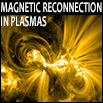Speaker
Prof.
Minna Palmroth
(Finnish Meteorological Institute, Helsinki, Finland)
Description
Vlasiator (http://vlasiator.fmi.fi) is a newly developed, global hybrid-
Vlasov simulation, which
solves the six-dimensional phase space utilising the Vlasov equation for
protons, while electrons
are treated as a charge-neutralising fluid. The outcome of the
simulation is a global reproduction
of ion-scale physics where the generation of physical features can be
followed in time and their
consequences can be quantitatively characterised. Vlasiator produces
the ion distribution
functions and the related kinetic physics in unprecedented detail, in the
global scale
magnetospheric scale with a resolution of a couple of hundred
kilometres in the ordinary space
and about 30 km/s in the velocity space. We currently run Vlasiator
under a southward IMF in
five dimensions consisting of a three-dimensional velocity space
embedded in the polar (XZ)
plane. The simulation box extends 40 Earth radii (RE) in the solar wind
upstream direction and a
hundred RE in the nightside, thus including the dayside and the
nightside reconnection sites in a
single simulation volume. This introduces an opportunity to investigate
kinetic reconnection
physics in the global system, from the solar wind, through the
magnetosheath and
magnetopause, and eventually the nightside reconnection as a
consequence of other processes
with realistic boundary conditions. We observe the formation of 2-
dimensional representations of
flux transfer events at the magnetopause, and a substorm process in
the nightside. We quantify
reconnection rates and other relevant reconnection parameters and
compare to earlier
literature, with the aim of discussing the substorm process as a
consequence of the global
system evolution.
Author
Prof.
Minna Palmroth
(Finnish Meteorological Institute, Helsinki, Finland)
Co-authors
A. Sandroos
(Finnish Meteorological Institute, Helsinki, Finland)
H. Hietala
(Imperial College, London, UK)
O. Hannuksela
(Finnish Meteorological Institute, Helsinki, Finland)
R. Vainio
(University of Turku, Turku, Finland)
S. Hoilijoki
(Finnish Meteorological Institute, Helsinki, Finland)
S. von Alfthan
(Finnish Meteorological Institute, Helsinki, Finland)
T. V. Laitinen
(Finnish Meteorological Institute, Helsinki, Finland)
U. Ganse
(University of Helsinki, Helsinki, Finland)
Y. Pfau-Kempf
(Finnish Meteorological Institute, Helsinki, Finland)

